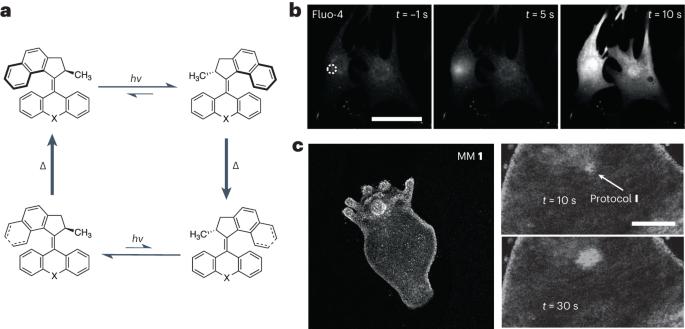Photomechanical molecular machines enable control of cell signalling
IF 38.1
1区 材料科学
Q1 MATERIALS SCIENCE, MULTIDISCIPLINARY
引用次数: 0
Abstract
Intercellular calcium waves (ICW) are mechanosensitive signalling phenomena that coordinate cellular responses in key physiological processes. The force applied by light-activated molecular machines is shown to remotely stimulate ICW. The ICW induced by these molecular machines can be exploited to regulate downstream functions, such as muscle contraction, in vitro and in vivo.

光机械分子机器能够控制细胞信号。
细胞间钙离子波(ICW)是一种机械敏感信号现象,可协调关键生理过程中的细胞反应。光激活分子机器施加的力可远程刺激细胞间钙波。这些分子机器诱导的 ICW 可用于调节体外和体内的下游功能,如肌肉收缩。
本文章由计算机程序翻译,如有差异,请以英文原文为准。
求助全文
约1分钟内获得全文
求助全文
来源期刊

Nature nanotechnology
工程技术-材料科学:综合
CiteScore
59.70
自引率
0.80%
发文量
196
审稿时长
4-8 weeks
期刊介绍:
Nature Nanotechnology is a prestigious journal that publishes high-quality papers in various areas of nanoscience and nanotechnology. The journal focuses on the design, characterization, and production of structures, devices, and systems that manipulate and control materials at atomic, molecular, and macromolecular scales. It encompasses both bottom-up and top-down approaches, as well as their combinations.
Furthermore, Nature Nanotechnology fosters the exchange of ideas among researchers from diverse disciplines such as chemistry, physics, material science, biomedical research, engineering, and more. It promotes collaboration at the forefront of this multidisciplinary field. The journal covers a wide range of topics, from fundamental research in physics, chemistry, and biology, including computational work and simulations, to the development of innovative devices and technologies for various industrial sectors such as information technology, medicine, manufacturing, high-performance materials, energy, and environmental technologies. It includes coverage of organic, inorganic, and hybrid materials.
 求助内容:
求助内容: 应助结果提醒方式:
应助结果提醒方式:


